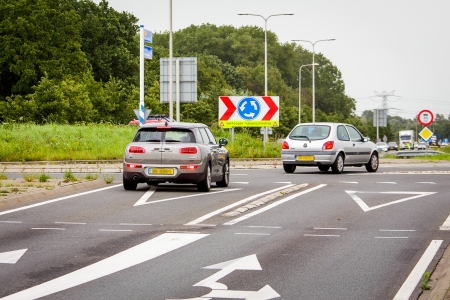The first determining characteristic for intersection safety is the type of intersection. Signalised intersections, for example, are less safe than other intersection types because of their capacity, high traffic volumes and complexity (also see the section Which intersection types are safest?)
Moreover, each intersection type has characteristics that may affect its safety:
- the number of possible points of conflict;
- speed;
- differences in mass of vehicles that meet at the intersection;
- impact angle;
- the amount of traffic, broken down by the number of passing motor vehicles and the ratio between main flow and lateral flow.
Intersection safety strongly depends on the number of possible points of conflict: the fewer, the safer. A conflict between vehicles should only be possible when speed and mass differences are small. The impact angle is another important factor. The angle is determined by the type of conflict. Table 5 shows four different conflict groups.
|
Conflict group |
Description |
Illustration |
|
Lateral conflicts |
Vehicles at perpendicular angles
|
|
|
Rear-end conflicts |
Vehicles driving in same direction |
|
|
Converging or diverging conflicts |
Vehicles starting or ending up in same direction (merging or exiting) |
|
|
Frontal conflicts |
Oncoming vehicles
|
|
Table 5. Four conflict groups [9].
A last important characteristic is the traffic volume: the more passing vehicles, the more crashes. The way in which this contributes to intersection safety was studied in two ways. For the urban area, the number of passing vehicles was studied [9]. This is the sum of lateral flows and main flow. For intersections outside the urban area, the ratio between lateral-flow volume and main-flow volume was studied. This ratio is strongly related to the number of injury crashes [16][i].
For a comprehensive description of the characteristics that affect intersection safety, see SWOV report Several aspects of intersection safety.
[i] This is based on existing knowledge that was investigated in this way. The number of passing motor vehicles was only studied for the urban area, and the ratio between lateral flows and main flow was only studied for intersections outside the urban area. Both traffic volume and distribution are, however, relevant to road safety both in and outside the urban area.
